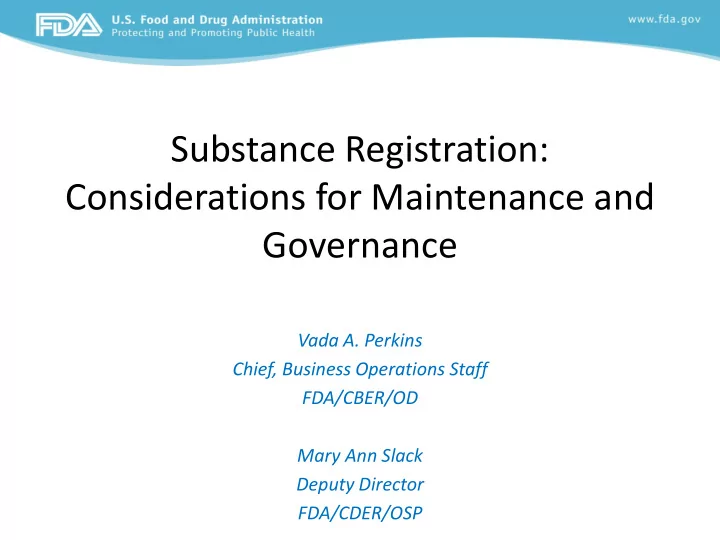

Substance Registration: Considerations for Maintenance and Governance Vada A. Perkins Chief, Business Operations Staff FDA/CBER/OD Mary Ann Slack Deputy Director FDA/CDER/OSP
Substance Identification: In Regulatory Practice • Regulators/Industry must understand and be provided with the defining elements and criteria associated with substance identification • Industry/regulators should evaluate the substance information following established criteria – EN ISO 11238:2012(E)- Data elements and structures for the unique identification and exchange of regulated information on substances
Substance Identification: Regulatory Use Cases Throughout the Product Lifecycle • Investigational – Clinical trials • Tracking formulation/dose changes throughout the investigational process • Goal: Associating substance to ALL investigational and marketed products throughout the FDA – Clinical trial registration requirements (Industry) • Repurpose • Pre-Market – New drug/biologic review – Pre-approval inspections • Post-Market – Pharmacovigilance • Adverse events/adverse drug reaction reporting – Compliance • Product-Establishment relationship – Supply chain – Counterfeiting • Import/export • Voluntary recalls
Regulatory Review Process for Product- Substance Association (US) High Level Procedures 1. After an application is accepted from Industry, a request for a Unique Ingredient Identifier (UNII)is submitted by the FDA product office to FDA-SRS with the following information: a. Draft labeling b. List of ingredients (active and inactive) c. Additional information may be required Note: Target timeframe for receipt of UNII Code assignment from FDA-SRS is 4-6 weeks 2. Forward the completed initial UNII Code assignment recommendation to the FDA product reviewer
Process within the US (cont.) 3. FDA product reviewer concurs with the identifying description based on his/her review of the application – If discrepancies are identified, consultation FDA-SRS or the company is initiated to resolve any issues 4. FDA notifies the company through official regulatory communication of the UNII code assignment • Note: Information is validated once the electronic labeling file (HL7 SPL) is resubmitted to FDA for public posting via validation business rules. Files are rejected and submitted back to sender to address any deficiencies • Ensures that substance information associated with product(s) is verified and accurate to the greatest extent possible.
Understanding the Internal/External Interface: Current Practice • Substance registration and use maintained internally – Within the FDA firewall – Protection of confidential/trade secret information • Two way communication/updates from internal to external sources (public information) based on internationally accepted “sources of truth” and confidentiality/trade secret requirements • To the extent it is public, regulators with legal requirements can push to GinAS once information is publicly available
Fundamental Maintenance Organization (MO) Criteria • Initial creation of the controlled vocabulary, including associated controlled sub-vocabularies; • Change requests for both new and existing terms, non-preferred terms and synonyms • Process/procedure for handling multiple translations • Change requests for both new and existing underlying definitions • Up-to-date publication of change release documentation reflecting significant updates and additions • Maintenance of the technical implementation of the structures in response to changes
ISO Draft Technical Report (DTR) 14872 • ISO is developing a draft technical report that describes the maintenance model and core principles for implementation and use of the suite of ISO Identification of Medicinal Products (IDMP) standards. • ISO TR 14872 identifies fundamental requirements that an ISO IDMP MO should address: – Receiving requests for change – Categorization of changes – Authorization of changes – Producing change schedules – Planning/testing changes – Implementing changes – Reviewing the changes to ensure successful adoption/integration
GInAS Possibilities
FDA Requirements for Substance ID Maintenance • Must Maintain Substance ID For Pre And Post Market Substances • Must Support Confidential/Trade Secret Information – Safeguard against unauthorized access – Post online only after information is publicly available – Not ALL defining elements that describe a substance may be in the Public Domain • Authoritative Source – Safeguard data integrity – Safeguard against improper/inappropriate data • No automatic acceptance of substance information • Information must be verified and validated before acceptance
GInAS and Substance Identification -- Possibilities
Minimal Requirements • All GInAS participants comply with ISO 11238 for Substance Identification • Each Regulatory Authority can maintain its own Substance Registration ( minimum impact to its regulatory process ) • Regulatory Authorities can establish agreements with each other for substance registration & maintenance if they choose • GInAS provides a source of public data to stakeholders
Possible GInAS Roles • Repository of publicly available substance information and IDs • Resource for Global Substance ID that maps to Regional IDs (Harmonization) • Registration & Maintenance Organization for Unique Substance IDs • Others?
What Would These Roles Require? What Is Possible? • Repository of publicly available substance information and IDs This requires: – Availability (24x7 ?) – Accessibility (Web, Mobile ?) – Data Integrity (Trusted source or resource only?) – Repository maintenance – Funding model • Resource for Global Substance ID that maps to Regional IDs (Harmonization) All of the above requirements, plus: – Authoritative (trusted) source – Governance body – Governance processes – Handling substance IDs with partial information (FDA’s confidential information issue) • Registration & Maintenance Organization for Unique Substance IDs All of the above requirements, plus: – Additional level of governance – Ensure data confidentiality and controlled access – Service level agreement
Discussion For Internal Use
Recommend
More recommend